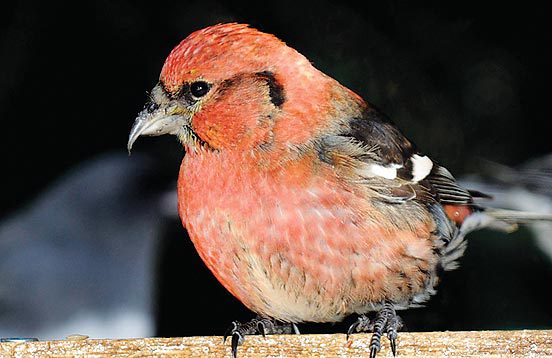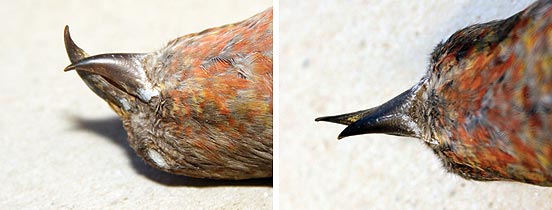White-winged Crossbills: Ecology and Conservation During an Irruption Year
By Clara McCarthy
April 15, 2009
Invasion of the Cone Snatchers
Improving birding skills is a never-ending quest for most birders. This winter, White-winged Crossbills left the boreal forests for southern Canada and as far south as Virginia, Kentucky, and Kansas, providing excellent practice for many birders to hone a wide range of birding skills. Birders studied the crossbills’ chip chip notes, looked for the definitive bill shape and white wing bars, and observed characteristic behaviors as the birds fed on conifer cones and picked up grit. The birds were fun to photograph and digiscope, and also to report and track via the Great Backyard Bird Count and eBird.
Crossbills provided an opportunity to focus on fascinating fine points. Each crossbill holds cones with one foot—virtually always the one opposite the direction the lower mandible turns. This way, the bird can separate cone scales with the crossed bill and then pry seeds out with its tongue or hook them with its long upper mandible. A birder must look closely to observe this, but most crossbills are tolerant of close observation.

About three-quarters of all White-winged Crossbills have lower bills that twist to the right. This species eats spruce, tamarack, and other cones that aren’t held tightly to trees, so the birds often snip or break off a cone and then position it in their foot to extract the seeds. Red Crossbills specialize on pine cones, which are much more securely attached to branches and harder to break off. So each Red Crossbill may be able to feed efficiently from just part of a given cone, leaving the seeds that birds with the opposite bill-crossing can exploit. Interestingly, in Red Crossbill populations, bills crossing to the right and to the left occur with equal frequency.
Crossbills have been recorded nesting during every month of the year, but only when food is abundant. Late this winter, many birders practiced their nest watching skills by searching for evidence of crossbill breeding.
Understanding each species’ conservation needs is another birding skill. Even though White-winged Crossbills occasionally breed in the south, the long-term health of crossbill populations is tied to the boreal forest, an ecoregion being cut for timber, fossil fuel extraction, and agriculture. After logging, newly germinated conifers may take 30 years to produce cones, and another 30 years to maximize production. Although only a small portion of the boreal forest is protected, it is one of the most intact forest systems on earth, and so there may still be time for successful conservation of abundant, high-quality habitat, protecting White-winged Crossbills and all the other wildlife that share their boreal home.
Originally published in the April 2009 issue of BirdScope.

All About Birds
is a free resource
Available for everyone,
funded by donors like you
American Kestrel by Blair Dudeck / Macaulay Library
